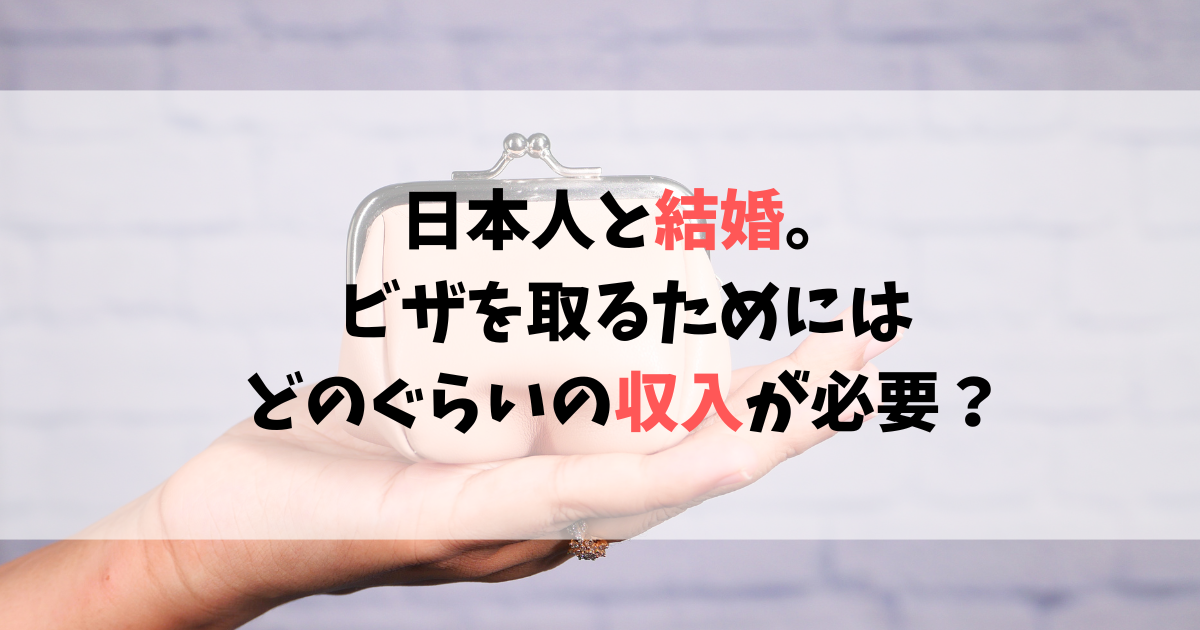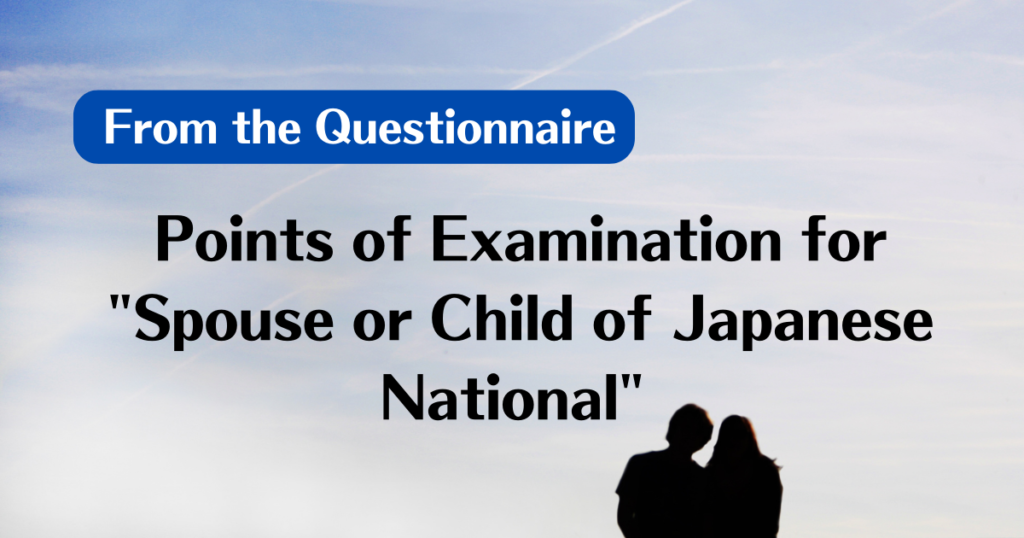
When applying for a “Spouse or Child of Japanese National” visa, one of the required documents is a “Questionnaire”. In the Questionnaire, you will be asked about how you met, dated, married, and have been married up to the present. Since these questions are asked to confirm that it is not a “sham marriage”, it is advisable to be as detailed as possible. In this part, we will look at typical examples of what cases are likely to be suspected of “sham marriages” based on the contents of the “Questionnaire”.
*The same notes apply to the “Questionnaire” for “Spouse or Child of Permanent Resident”. Please refer to the following.
Examination Points for “Spouse or Child of Japanese National” Status of Residence

For the status of residence (visa) of “Spouse or Child of Japanese National,” the examination will focus on two major themes: whether the marriage relationship is true and whether the applicant can live a stable life financially. There are many other detailed themes, but in this part, we will explain “whether the marriage relationship is true”.
Point (1): Marital relationship must be true
In the case of a “Spouse or Child of Japanese National”, the marriage must be true.
An “untrue marriage” is a marriage solely for the purpose of obtaining a visa, a sham marriage that is not actually a married relationship, or a marriage that is in effect divorced but is continued for visa purposes only.
Compared to a working visa, a “Spouse or Child of Japanese National” has more relaxed requirements for permanent residence or naturalization, and there are no restrictions on employment. For this reason, it is easy to be abused, and the Immigration Service Agency is paying special attention to “sham marriages” .
For these reasons, when applying for “Spouse or Child of Japanese National”, you must write a detailed description of how you met, how you got together, and how you got married in a fixed format called a “Questionnaire”, to show that it is a “true marriage” .
In this “Questionnaire”, especially “how you met” and “duration of relationship” will be checked to see if they do not fall into the “pattern of many sham marriages”.If your marriage falls under this pattern, you should actively appeal that it is not a “sham marriage” in order to obtain permission more smoothly.
Point 2:The couple must live together and mutually help and support each other.
In the case of “Spouse or Child of Japanese National” status, there is no clear “annual income requirement”, but it is necessary to prove that you can lead a stable life in Japan. Basically, it is important to show that the two of you can live without incurring monthly deficits based on your income and assets. Income can be the foreigner’s own, the spouse’s (wife/husband), or both (total), as long as the income is expected to be sufficient to live on.
In this part, we will focus on the “Questionnaire” (how you met – how you got into a relationship – how you got married). Please refer to the following article for a detailed explanation of point (2), “Annual Income”, as well.
Questionnaire mainly confirms whether the “marital relationship is true”.

The Immigration Service Agency strictly examines “Spouse or Child of Japanese National” because there are many cases of sham marriages for the purpose of obtaining status of residence. We will give typical examples of “meeting” and “duration of the relationship”, which are particularly susceptible to suspicion, and explain what kind of questions will be asked in the “Questionnaire”.
Cases (typical examples) that are likely to raise suspicions that the marital relationship is untrue
The following are examples of cases that may raise suspicions that the marriage is a sham.
・When the duration of the relationship is extremely short.
・When both parties cannot understand each other’s language.
・When there is a significant age difference
・If the Japanese partner has been married to a foreigner repeatedly in the past.
Nowadays, It is not uncommon for people to get married using dating apps or to get married quickly after a short dating period.However, the screening process is based on “written documents” only, so If the documents submitted do not show that the “marital relationship is true”, the permission will not be granted.In the above cases or cases similar to the above, we recommend that you be aware of this and make an effort to show that your marriage relationship is true.
If you are suspected of having a “sham marriage”,( even if it is not really a sham marriage, )you will not be granted a permit while you remain “under suspicion“. However, the immigration inspector must make a decision based solely on the documents submitted. Therefore, you need to explain firmly that it is a “true marriage relationship” by yourself.
What the “Questionnaire” asks
Let’s review the actual questionnaire with some excerpts.
Development leading to the marriage (About Meeting – Dating – Marriage – Present)
First of all, basic status is asked in “Question 1”, followed immediately by in-depth questions from “Question 2”.

It may seem embarrassing to even recall, but as it says ” as much detail as possible,” it is best to be very detailed. The following is an example of what to describe.
【Interaction before dating】The length of time between meeting and dating, the number of times you interacted, what attracted you to each other, and what led you to get into a relationship.
【During the dating period】: How often did you communicate during the dating period, about your relationship (where did you go, how many times per month did you see each other), did you travel to and from each other’s country?
【Consideration of Marriage】When did you start thinking about marriage, and how and when did you decide to marry that person?
【Marriage】About the Proposal, Introduction to each other’s parents and relatives
【From marriage to present and future】References to family structure and marital relationships, work and other aspects of life, and (for those in Japan) life in Japan *It would be better to summarize this in connection with the circumstances that led you to the marriage.
*It is best to write these in chronological order.
There is not much space in the “Questionnaire” to explain after the explanation in the “Development leading to the marriage ” section. Therefore, if you feel that your case falls under “a case in which a sham marriage is likely to be suspected,” it is advisable to provide a detailed explanation in the description section (1) or to prepare a separate “Explanatory Statement” to provide a detailed explanation.
Existence of a intermediary
After writing the “Dvelopment leading to the marriage” as described above, you will be asked the following questions . First, about the Existence of a intermediary. Especially if you used a marriage agency, it is a good idea to write in detail about the relationship between the person who introduced you and the applicant, including the reason for using the agency (his/her thoughts on marriage).
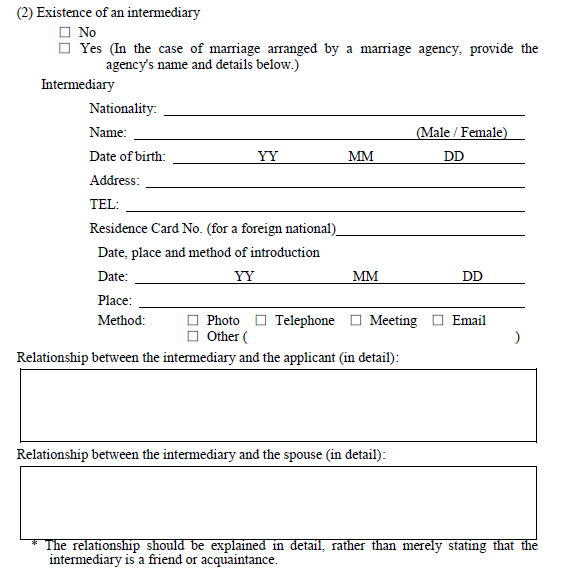
About the duration of the relationship - language issues and duration
Question 3 asks about communication between the couple. It is easy to explain if one of you speaks the language of the other’s country, but this may not be the case. Questions (5) and (6) ask about language acquisition and communication methods. If you are not speaking in each other’s native language, explain the language used between you and your spouse, if any, and if you are speaking through a translation application or interpreter, explain so that it is understood.
Japanese language level is not a requirement for “Spouse or Child of Japanese National,” but it is a good idea to actively promote any efforts you are making to improve communication (e.g., attending a language school, etc.).
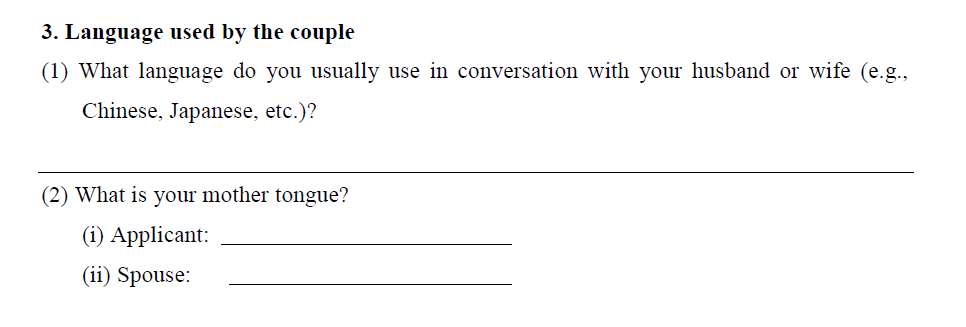
Questions 7 and 8 will ask you about your travel to and from each other’s country. It is advisable to write these items accurately while looking at your passport. Also, do not be lazy and fill in all of the information.
In particular, if you met through introductions while both of you were in your home countries, and if you have been dating for a short period of time or have barely met each other, it is necessary to fully explain how you came to be married.
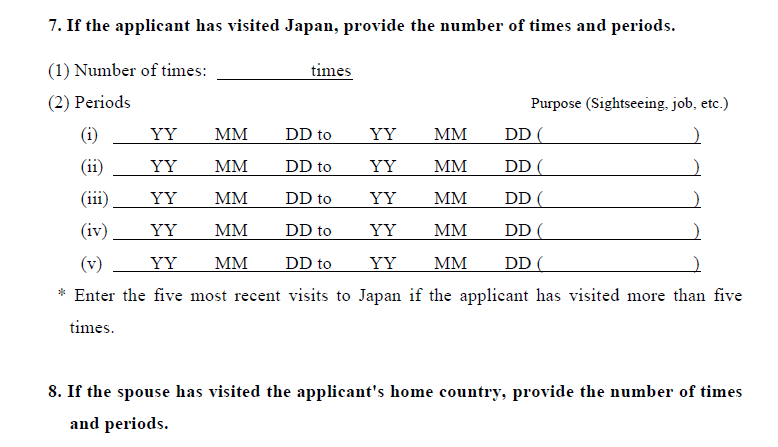
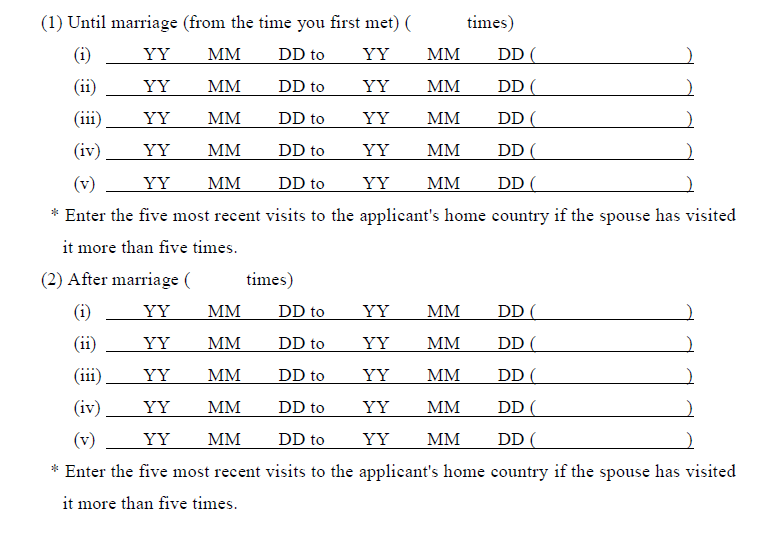
Has the Japanese side been married to a foreigner repeatedly in the past?
If you are married to a Japanese national, you will be granted the status of residence of “spouse or child of Japanese national.” This status has no restrictions on employment, and the fact that you are “married to a Japanese national” is a point for easing requirements when applying for permanent residence or naturalization. For this reason, some people repeatedly get married and divorced for money.
This is not to say that a second marriage will not be permitted, but Question 6’s intention is to make sure that you are not married for another purpose.
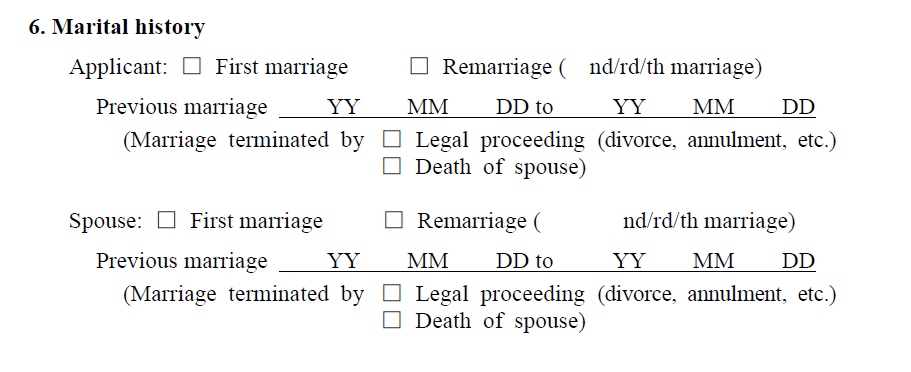
What to do if you don’t have enough space in your “Questionnaire” to answer the questions.

As you can see from the questionnaire, there is very little space to write about each item, except for “Question 2”.Therefore, even if you think “this point will be questioned by the examiner”, you will not have an opportunity to explain it in detail within the “Questionnaire”.
In such cases, we recommend that you prepare a free-format “Explanatory Statement” on a separate sheet of paper and explain in detail. It is also effective to submit more screenshot of emails, social networking messages, phone call records, etc. to show that you are interacting each other. As for snapshots, the list of required documents on the Immigration Service Agency website says “2 or 3 leaves (sheets)”, but you may submit more for each time line or event.
▶Immigration Service Agency: Status of residence “Spouse or Child of Japanese National” (when the foreigner (applicant) is the spouse (husband or wife) of a Japanese national)
Conclusion
The above is an explanation of the key points of the examination for “Spouse or Child of Japanese National” as seen in the “Questionnaire”.
If you are suspected of having a “sham marriage”, you will not be granted permission while you “remain under suspicion”. You must explain that you are in a “true marriage relationship”. Since the examination is done in writing, you need to make sure that the examiner can read it as a true marriage just from what you submit. For this reason, you must make a strong appeal with a “Questionnaire” and in some cases a “Statement of Explanation,” as well as objective photographs showing your relationship status.

【Advice from an administrative scrivener】
The questionnaire should be very detailed. However, you may not always know how to write “in detail”. If this is the case, please contact our office.

